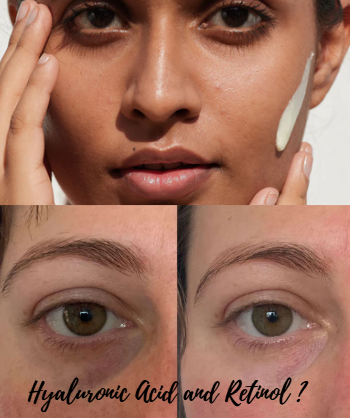
When it comes to skincare, two powerhouse ingredients always steal the spotlight—Retinol and Hyaluronic Acid. Both are hailed for their impressive benefits, but they work in completely different ways. If you’ve ever found yourself wondering which one is right for you—or if you can use them together—you’re in the right place. Let’s break it down in simple terms.
Understanding the Difference Between Retinol and Hyaluronic Acid
Think of Retinol as the trainer at the gym pushing your skin to work harder, and Hyaluronic Acid as the hydration coach keeping everything smooth and supported.
- Retinol is a Vitamin A derivative that penetrates deep into the skin, promoting cell turnover and boosting collagen production. It fights wrinkles, fine lines, and uneven tone.
- Hyaluronic Acid (HA), on the other hand, is a natural humectant. It pulls water into your skin, making it instantly plumper and more hydrated.
In short: Retinol renews, while Hyaluronic Acid hydrates.
Which is Better for Fine Lines and Wrinkles?
If wrinkles are your biggest concern, Retinol takes the crown. Numerous studies confirm that Retinol stimulates collagen and blood vessel production, which gradually reduces fine lines and makes skin firmer.
However, patience is key. Retinol isn’t a quick fix—it may take several months before you notice real results. Hyaluronic Acid, on the other hand, gives you immediate plumpness but doesn’t rebuild collagen. That’s why many dermatologists recommend combining both: Retinol for long-term anti-aging and Hyaluronic Acid for instant smoothness.
Video : Hyaluronic Acid vs. Retinol: Which Works Better?
Which Works Better for Acne?
When it comes to acne, Retinol is hands down the winner. It unclogs pores, reduces inflammation, and prevents future breakouts. It’s even FDA-approved for acne treatment.
Hyaluronic Acid doesn’t directly fight acne, but it helps balance oil production and soothes irritation. If you struggle with dry, sensitive, or acne-prone skin, layering HA under Retinol can prevent excessive dryness while still targeting breakouts.
Best Choice for Dark Circles
Dark circles are tricky, but here’s the deal: Retinol can be too harsh for the delicate under-eye area. That’s where Hyaluronic Acid shines. It hydrates and plumps the skin under your eyes, making shadows less noticeable. If puffiness and fine lines are also issues, HA-based eye creams are much safer and gentler than Retinol.
Can You Use Retinol and Hyaluronic Acid Together?
Absolutely—and in fact, they’re a dream team. Retinol can sometimes cause dryness or irritation, and that’s where HA comes in to balance things out. Applying HA first locks in moisture, and Retinol follows with its deeper corrective action. Together, they create a routine that’s both powerful and gentle.
One clinical study even found that a combination of low-concentration Retinol and Hyaluronic Acid significantly improved wrinkles and overall skin texture compared to using them separately.
Can Hyaluronic Acid Prevent Retinol Purge?
Here’s the truth: Hyaluronic Acid can’t stop the dreaded Retinol purge (those tiny breakouts some people get when starting Retinol). Purging happens because Retinol speeds up skin cell turnover, pushing impurities to the surface.
What HA can do, however, is make the process less uncomfortable. It keeps your skin barrier strong, reduces dryness, and helps you push through the adjustment phase with less irritation. Think of it as giving your skin a soft cushion while Retinol does the heavy lifting.
How to Use Them in Your Routine
- Apply Hyaluronic Acid first on damp skin to lock in hydration.
- Wait a few minutes, then layer on Retinol at night.
- Always follow up with a moisturizer to seal everything in.
- And don’t forget sunscreen during the day—Retinol makes skin more sun-sensitive.
Video : Can you use retinol and hyaluronic acid together?
Conclusion
So, Retinol or Hyaluronic Acid—which one should you use? The answer depends on your goals. If your main concern is aging, Retinol is your go-to. If you’re after hydration and a plumper look, Hyaluronic Acid is perfect. But why choose when you can use both?
Together, they balance each other beautifully—Retinol drives long-term transformation, while Hyaluronic Acid keeps your skin hydrated, soothed, and glowing. Use them wisely, stay consistent, and your skin will thank you.


